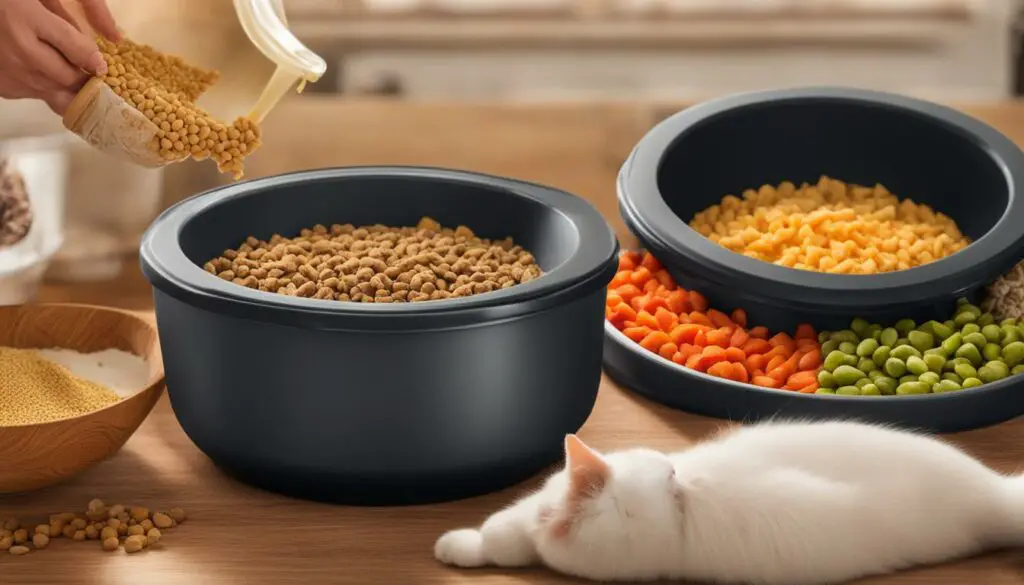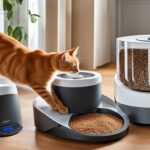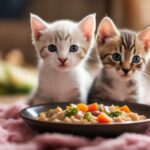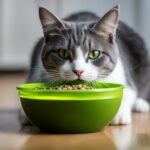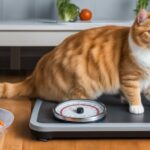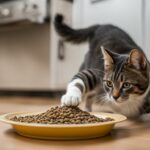Greetings, fellow cat lovers! Today, I want to share some effective methods on how to stop free feeding cats. Free feeding, or leaving food available at all times, may seem convenient, but it can lead to obesity and overeating in our feline friends. Transitioning cats to a timed feeding schedule is essential for promoting healthier eating habits and weight management. Let’s explore the steps to make this transition a success!
Key Takeaways:
- Transitioning from free feeding to a timed feeding schedule is important for a cat’s health and weight management.
- Free feeding can lead to obesity and overeating in cats.
- Establishing a feeding schedule based on your cat’s age, health, and activity level is crucial.
- Consulting with a veterinarian and monitoring your cat’s progress during the transition is recommended.
- Consider incorporating natural feeding habits and activities into your cat’s routine for overall well-being.
The Dangers of Free Feeding Cats
Free feeding cats, or leaving food available to them at all times, can have detrimental effects on their health. It may lead to issues such as obesity and diabetes, as well as nutritional deficiencies. Cats need a diet that is primarily composed of animal-based protein, and free feeding may not provide them with the appropriate nutrients they require. Transitioning to a scheduled feeding routine can help prevent overeating and ensure that cats receive the proper portions of food.
In order to understand the dangers of free feeding, it’s important to consider the impact on a cat’s overall health. Obesity is a significant concern, as it can lead to a range of health problems including joint issues, heart disease, and diabetes. Cats metabolize carbohydrates differently from humans and dogs, making them more prone to weight gain from excessive carbohydrate consumption. Additionally, free feeding can lead to nutritional imbalances if cats are consuming primarily dry kibble, which may not provide the necessary moisture content or essential nutrients.
Transitioning from free feeding to a scheduled feeding routine can help address these issues. By providing set mealtimes, pet owners can control the amount of food their cats consume and ensure they are receiving proper nutrition. It also allows for portion control, which is crucial for maintaining a healthy weight. By monitoring their cat’s food intake and adjusting portion sizes as needed, pet owners can help prevent overeating and obesity.
The Importance of Portion Control for Cats
Portion control is a crucial aspect of cat feeding. It involves determining the appropriate amount of food to feed your cat at each meal based on their age, weight, and activity level. Portion control helps prevent overeating and ensures that cats are receiving the right amount of calories and nutrients. It is important to consult with your veterinarian to determine the ideal portion size for your cat, as individual needs may vary.
| Portion Control Tips for Cats | Benefits |
|---|---|
| Use a measuring cup to accurately portion out your cat’s food. | Prevents overfeeding and helps maintain a healthy weight. |
| Divide the daily recommended food into multiple small meals. | Allows for better digestion and prevents hunger between meals. |
| Monitor your cat’s body condition regularly. | Helps ensure that portion sizes are appropriate for their weight and activity level. |
By implementing portion control and transitioning from free feeding to a scheduled feeding routine, pet owners can help promote their cat’s overall health and well-being. Providing the right amount of food at designated mealtimes ensures that cats are receiving the appropriate nutrition and helps prevent the development of health issues associated with free feeding.
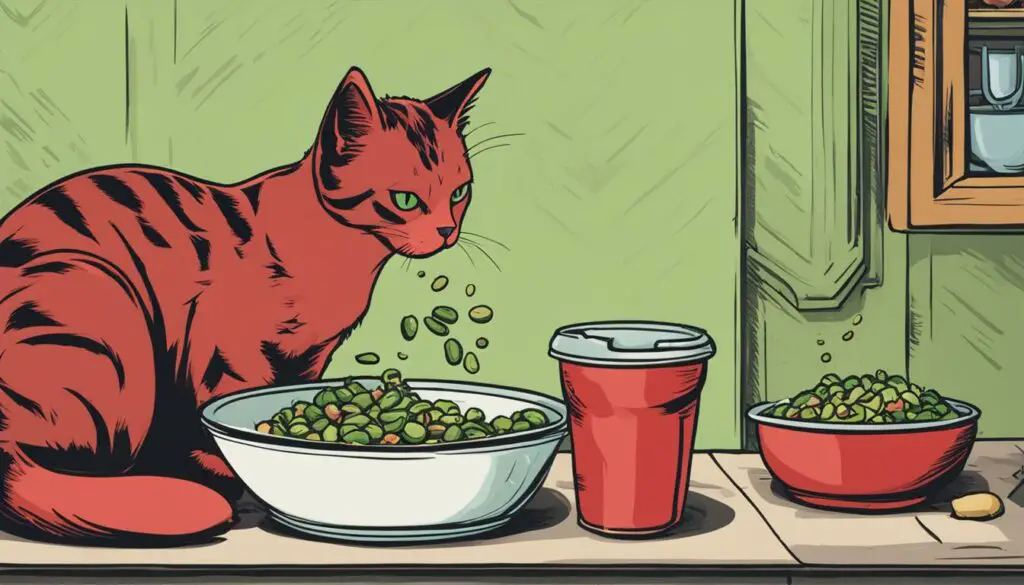
Establishing a Feeding Schedule
Transitioning cats from free feeding to a scheduled feeding routine is essential for their health and well-being. By establishing a feeding schedule, pet owners can ensure that their cats receive the proper nutrition, manage their weight effectively, and promote healthier eating habits. Here are some steps to help you establish a feeding schedule for your cat:
- Determine the timing and frequency of meals based on your schedule: Take into consideration your daily routine and determine the best times to feed your cat. Aim for consistency by feeding meals at the same time every day.
- Designate a feeding area: Choose a designated area where you will feed your cat. This can help create a sense of routine and association with mealtime.
- Use a signal: Establish a signal, such as a specific word or sound, to let your cat know it’s mealtime. This can help them recognize when it’s time to eat and prevent begging or demanding behavior outside of scheduled meal times.
- Measure food intake: Start by measuring how much food your cat currently consumes in a 24-hour period. This will give you a baseline to work with when portioning their meals. Gradually transition to portioned meals based on their calorie needs to ensure they are receiving the appropriate amount of food.
By following these steps, you can successfully establish a feeding schedule that promotes cat weight management, healthier eating habits, and overall well-being. Consistency is key, and with time, your cat will adapt to the new routine and thrive on the structured feeding schedule.
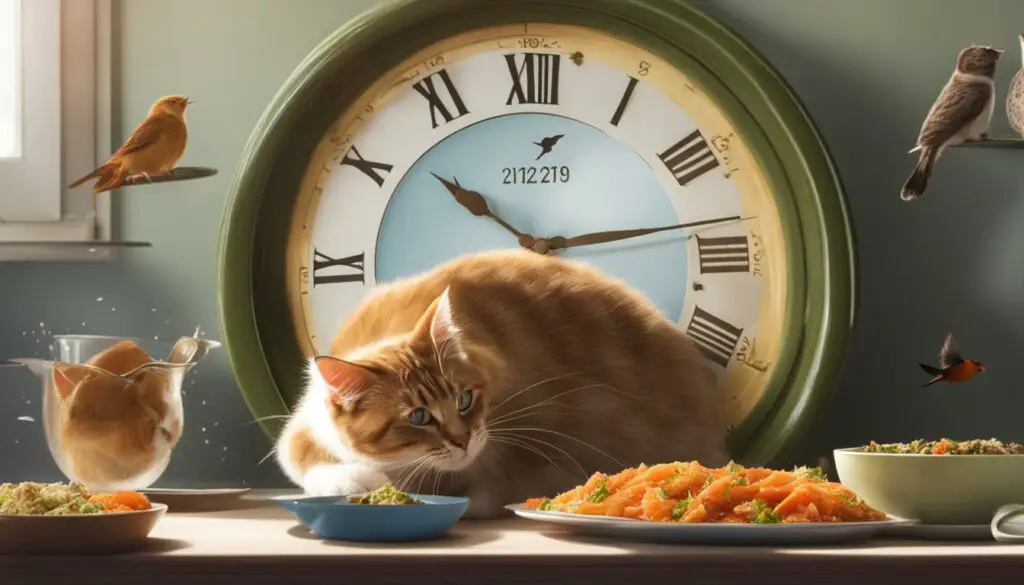
Benefits of a Feeding Schedule
Implementing a feeding schedule for your cat offers several benefits:
- Weight management: By controlling portion sizes and meal times, you can prevent overeating and manage your cat’s weight effectively. This is particularly important for cats prone to obesity.
- Promoting healthier eating habits: Scheduled feeding helps establish a routine and prevents grazing throughout the day, encouraging cats to eat their meals in one sitting. This can lead to better digestion and absorption of nutrients.
- Preventing food-related behavior issues: Cats can become demanding or exhibit food-related behavior issues when free feeding. A structured feeding schedule helps establish boundaries and reduces the likelihood of these behaviors.
- Bonding and training opportunities: Feeding your cat at specific times creates bonding opportunities and allows you to incorporate training exercises during mealtime.
Example Feeding Schedule
Here is an example of a feeding schedule for an adult cat:
| Time | Meal | Portion Size |
|---|---|---|
| 7:00 AM | Breakfast | 1/4 cup |
| 1:00 PM | Lunch | 1/4 cup |
| 6:00 PM | Dinner | 1/4 cup |
Remember to consult with your veterinarian to determine the appropriate portion sizes and feeding schedule for your specific cat, as individual needs may vary based on factors such as age, weight, and activity level.
Calculating the Amount of Food to Feed
When transitioning from free feeding to a controlled feeding routine, it’s important to calculate the appropriate amount of food to feed your cat. This will help ensure they receive the right portions and maintain a healthy weight. There are two key calculations you can make to determine the amount of food your cat needs: their average daily consumption and the amount they eat in one sitting.
Calculating Average Daily Consumption
To calculate your cat’s average daily consumption, start by measuring the amount of food you typically leave out for them in a 24-hour period. Keep track of how much is left at the end of the day before refilling the bowl. This will give you an idea of how much your cat consumes on a daily basis. Divide this amount by the number of meals you currently provide to determine the average portion size for each meal.
Determining Portion Size per Meal
To determine the appropriate portion size for each meal, offer a measured amount of food and track how much your cat consumes in one sitting. Gradually adjust the portion size based on their intake and energy needs. It’s important to note that portion size may vary depending on factors such as age, activity level, and overall health. Consulting with a veterinarian can provide further guidance on tailoring portion sizes for your cat’s specific needs.
| Weight | Portion Size (per meal) |
|---|---|
| 6-8 lbs | ¼ – ⅓ cup |
| 9-12 lbs | ⅓ – ½ cup |
| 13-16 lbs | ½ – ¾ cup |
Monitoring Your Cat’s Weight
Regularly monitoring your cat’s weight is important to ensure they are maintaining a healthy weight. Keep track of their weight and body condition score, and make adjustments to the portion sizes as needed. If your cat starts gaining or losing weight, consult with your veterinarian for further guidance on adjusting their feeding plan.

Transitioning from Free Feeding
Transitioning cats from free feeding to timed meals is a gradual process that requires patience and consistency. By following a structured approach, you can successfully pull the free-feeding kibble and transition your cat to a healthier feeding routine. Here are the steps to consider:
- Start by pulling the free-feeding kibble at certain times of the day, such as overnight or when you’re away. This helps create defined meal times and encourages your cat to recognize that food will only be available during those times.
- Introduce timed meals during the day and gradually increase the amount of food at each meal to meet your cat’s daily caloric needs. This gradual increase prevents your cat from feeling deprived and helps them adjust to the new feeding routine.
- Monitor your cat’s intake and adjust portion sizes as needed. Each cat is unique, so it’s important to evaluate their body condition and weight throughout the transition. Consult with your veterinarian if you have any concerns or questions.
Remember, the key to successfully transitioning from free feeding to timed meals is consistency. Stick to the designated meal times and avoid giving in to begging or providing extra treats outside of the scheduled meals. With time, your cat will adjust to the new routine and develop healthier eating habits.
During the transition, it’s important to be mindful of your cat’s behavior and appetite. If your cat is struggling with the new feeding routine, consult with your veterinarian or a support group for guidance. They can provide additional tips and strategies to make the transition smoother for both you and your cat.
| Benefits of Transitioning from Free Feeding |
|---|
| 1. Promotes healthier eating habits and weight management |
| 2. Prevents overeating and obesity |
| 3. Allows for better portion control and monitoring of your cat’s intake |
| 4. Encourages a more balanced diet by offering specific amounts of food at each meal |
| 5. Helps establish a consistent feeding routine for you and your cat |
By transitioning from free feeding to timed meals, you are taking an important step towards ensuring your cat’s health and well-being. With the right approach and proper monitoring, you can help your cat maintain a healthy weight and enjoy a balanced diet.
Ideal Number of Meals for Cats
When it comes to feeding our feline friends, finding the ideal number of meals is essential for their health and well-being. While cats in the wild eat multiple small meals throughout the day, replicating this exact feeding pattern may not be practical for most cat owners. However, aiming for at least three meals a day is recommended to ensure cats receive the necessary nutrients and energy they need.
The number of meals can be adjusted based on factors such as your cat’s age, health, and activity level. Kittens, for example, may require more frequent meals due to their higher energy needs. On the other hand, senior cats may benefit from fewer meals to prevent overeating and maintain a healthy weight. Consulting with a veterinarian can provide insights into tailoring the feeding routine to your cat’s specific needs.
It’s important to note that the ideal number of meals should be part of a structured feeding schedule. This means establishing consistent meal times and portion control for each meal. By following a feeding routine, you can prevent obesity, promote a healthy metabolism, and ensure your cat receives the appropriate amount of food to maintain their overall health.
| Factors to Consider | Ideal Number of Meals per Day |
|---|---|
| Kittens | 4-6 meals |
| Adult Cats | 2-4 meals |
| Senior Cats | 2-3 meals |
Remember, the key to a successful feeding routine is consistency and portion control. By providing your cat with the appropriate number of meals each day, you can ensure they receive the necessary nutrients, maintain a healthy weight, and enjoy a happy, healthy life.
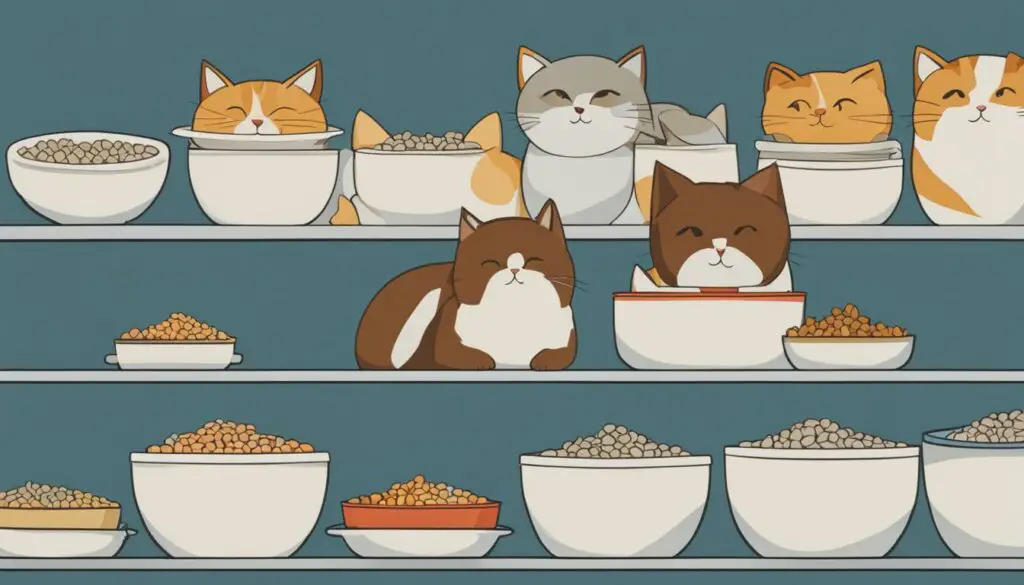
References:
- Feeding Your Cat: Know the Basics of Feline Nutrition.” The Humane Society of the United States, www.humanesociety.org/resources/feeding-your-cat.
- Feeding Your Cat.” Cornell Feline Health Center, Cornell University College of Veterinary Medicine, www.vet.cornell.edu/departments- centers-and-institutes/cornell-feline-health-center/health-information/feline-health-topics/feeding-your-cat.
Managing Morning Meals
When it comes to transitioning cats to a timed feeding schedule, establishing a consistent morning routine is essential. By avoiding the immediate association of waking up with being fed, you can create a healthier feeding routine for your feline friend. Here are a few tips to help you manage morning meals:
- Choose an activity: Instead of making feeding your cat the first task of the day, select a different activity that becomes the trigger for mealtime. This could be making coffee, taking a shower, or even doing a quick workout.
- Stick to a schedule: Consistency is key when it comes to establishing a feeding routine. By feeding your cat at the same time each morning, you condition them to expect their meal at that specific time.
- Limit attention-seeking behavior: If your cat has a tendency to wake you up for food, avoid reinforcing this behavior. Instead of feeding them immediately, engage in playtime or provide them with a stimulating toy to distract them.
By implementing these strategies, you can ensure that your cat’s morning meals are part of a structured feeding schedule that promotes healthier eating habits and prevents overeating.
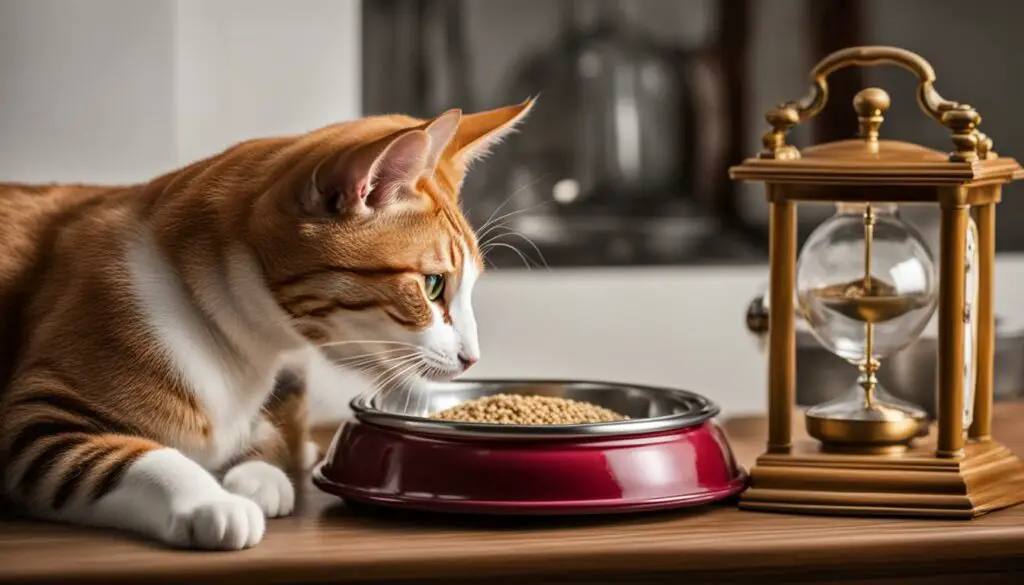
| Benefit | Why It Works |
|---|---|
| Promotes healthier eating habits | By establishing a consistent morning routine, your cat becomes less reliant on immediate feeding and learns to follow a structured feeding schedule. |
| Prevents overeating | By removing the association of waking up with being fed, you reduce the likelihood of your cat overeating out of habit or boredom. |
| Reduces attention-seeking behavior | By engaging your cat in alternative activities before feeding, you discourage them from seeking attention solely for food purposes and encourage mental stimulation. |
Troubleshooting the Transition
Transitioning cats from free feeding to timed meals may come with some challenges, but with the right approach, it can be a smooth process. Here are some cat feeding tips to troubleshoot common issues during the transition:
- Stomach acid buildup: Some cats may experience stomach acid buildup between meals, leading to vomiting. To alleviate this, offer small treats or interactive toys that can absorb excess stomach acid.
- Resisting the change: If your cat is resistant to the transition, try using a timed feeder. These devices can automatically dispense food at specific times, helping cats adjust to the new feeding routine gradually.
- Seek professional guidance: If you’re facing difficulties during the transition or have concerns about your cat’s health and appetite, it’s always a good idea to consult with a veterinarian. They can provide personalized advice and support to ensure a successful transition to timed meals.
Remember, patience and consistency are crucial when transitioning your cat to a new feeding schedule. With time and a bit of troubleshooting, you can help your cat establish healthier eating habits and prevent overeating.
Expert Tip: Addressing Stomach Acid Buildup
“To address stomach acid buildup, you can provide small, low-calorie treats or interactive toys during the transition to timed meals. These can help absorb excess stomach acid and reduce the chances of vomiting.”
Table: Troubleshooting Tips for Transitioning to Timed Meals
| Issue | Troubleshooting Tip |
|---|---|
| Stomach acid buildup | Offer small treats or interactive toys to absorb excess stomach acid |
| Resisting the change | Use a timed feeder to gradually adjust to the new feeding routine |
| Seek professional guidance | Consult with a veterinarian for personalized advice and support |
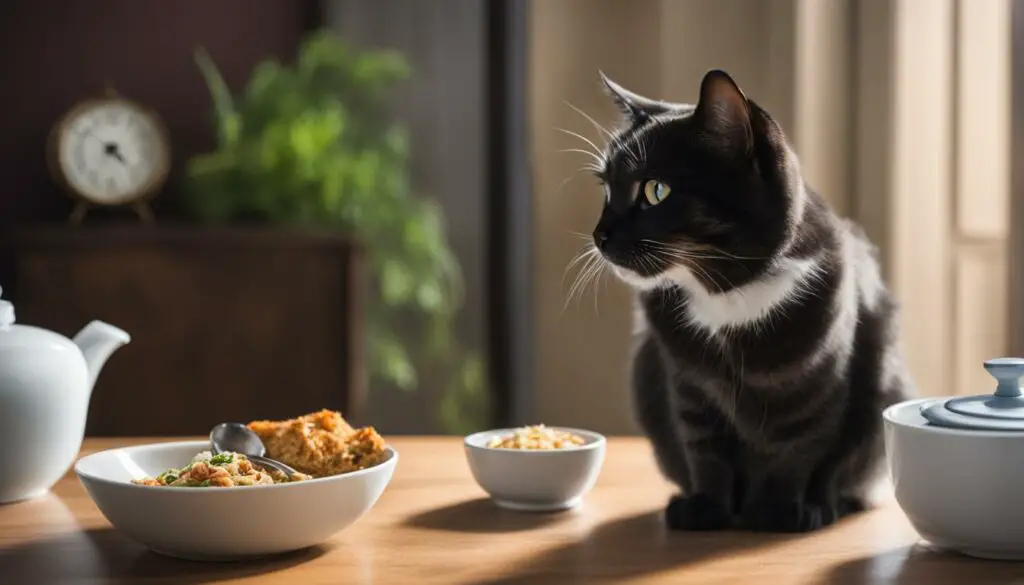
Tailoring Meals for Multiple Cats
When it comes to feeding multiple cats, it’s crucial to consider the unique needs of each feline family member. Tailoring meal plans based on their age, energy level, and any health conditions they may have is essential to ensure their overall well-being. By following a feeding routine that caters to the individual requirements of each cat, you can ensure they receive the appropriate nutrition and portion sizes.
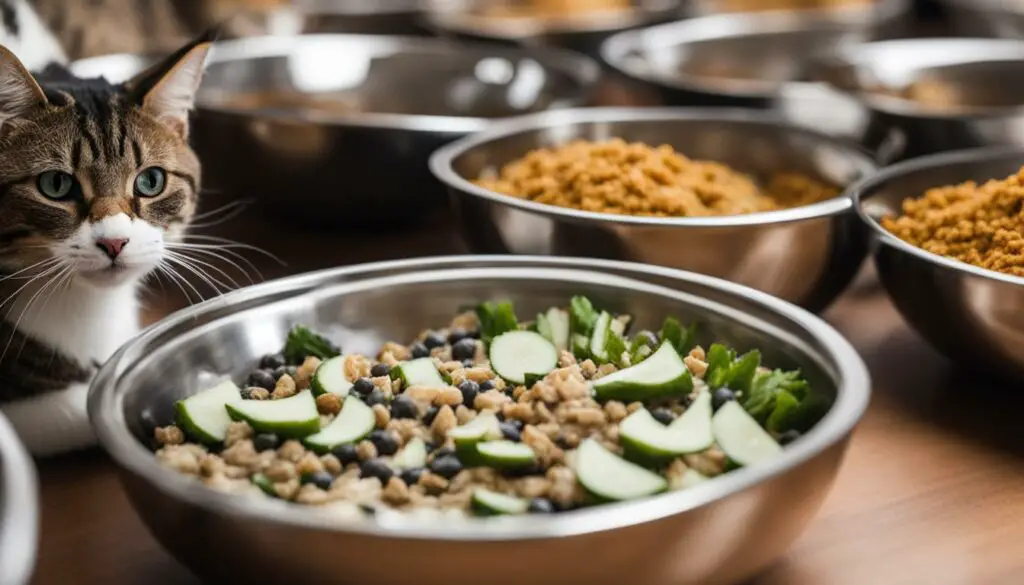
Creating a Meal Plan for Multiple Cats
To effectively tailor meals for multiple cats, start by calculating the daily calorie intake for each cat. This calculation should be based on their weight, activity level, and age. Once you have determined the ideal number of calories, divide this amount evenly among the specified number of meals per day.
| Cat | Daily Calorie Intake | Number of Meals | Calories per Meal |
|---|---|---|---|
| Cat 1 | 250 calories | 3 meals | 83.33 calories |
| Cat 2 | 300 calories | 3 meals | 100 calories |
| Cat 3 | 200 calories | 3 meals | 66.67 calories |
By dividing the daily calorie intake into smaller portions, you can ensure that each cat receives the right amount of food for their specific needs. This method helps prevent overeating and allows for better weight management.
Using Automatic Feeders
If you find it challenging to monitor each cat’s feeding routine individually, consider using automatic feeders. These devices allow you to program specific feeding times and portion sizes for each cat. Automatic feeders help ensure that each cat receives their designated meal without the risk of one cat consuming another’s food. Additionally, they can help establish a consistent feeding routine even when you are away from home.
By tailoring meals for multiple cats, you can provide each feline companion with the nutrition they require while promoting a balanced and healthy feeding routine. Taking into account their individual needs and using tools such as automatic feeders can simplify the process and help maintain harmony within your multi-cat household.
Consulting with a Veterinarian
When it comes to transitioning cats to a timed feeding schedule, consulting with a veterinarian is crucial. A veterinarian can provide valuable insight and guidance tailored to your cat’s specific needs. They will assess your cat’s current health, consider any dietary modifications that may be necessary, and monitor their progress as they adjust to their new feeding routine.
Regular check-ups with a veterinarian allow for adjustments to the feeding plan based on your cat’s individual needs. This is particularly important if your cat has any health issues or requires specific dietary considerations. By working closely with a veterinarian, you can ensure that your cat’s weight management and overall health are properly addressed.
Additionally, a veterinarian can offer support and guidance throughout the transition process. They can help troubleshoot any potential challenges or concerns that may arise, ensuring a smooth and successful transition to a timed feeding schedule. With their expertise and knowledge, you can feel confident in implementing a feeding plan that supports your cat’s well-being.
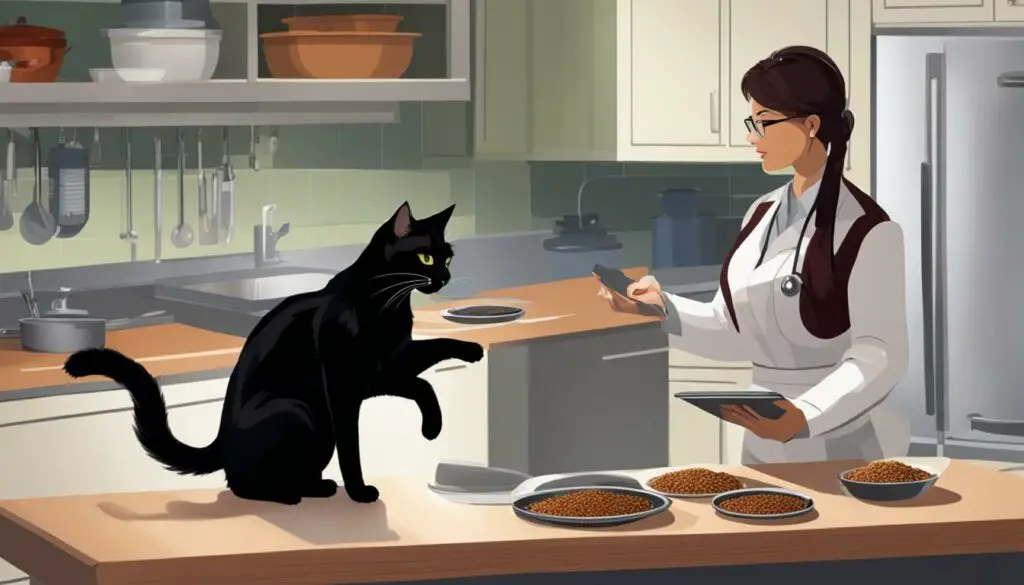
The Importance of Veterinary Guidance
Transitioning cats from free feeding to timed meals requires careful consideration of their unique needs. A veterinarian can provide valuable insights and recommendations to ensure that your cat’s feeding routine is optimized for their health and well-being.
| Benefits of Consulting with a Veterinarian |
|---|
| Personalized advice based on your cat’s specific needs |
| Monitoring and adjustment of feeding plan as needed |
| Guidance for addressing any health issues or dietary modifications |
| Support and troubleshooting throughout the transition process |
Incorporating Natural Feeding Habits
When it comes to feeding our cats, it’s important to keep in mind their natural instincts and behaviors. Cats are natural hunters, and incorporating activities that stimulate their hunting instincts into their daily routine can benefit their overall health and well-being. By doing so, we can help them maintain a healthy weight, stay mentally engaged, and even encourage them to try new foods.
One effective way to incorporate natural feeding habits is by using puzzle feeders. These interactive devices require cats to work for their food, simulating the experience of hunting and foraging. Puzzle feeders come in different designs, such as mazes and treat balls, and can be filled with dry or wet food. They provide mental stimulation and make mealtime more engaging for your cat.
Another option is to hide small amounts of food around your home. This mimics the hunting experience, as cats have to search and discover their food. You can hide food under furniture, in different rooms, or even in cat-friendly hiding spots. Not only does this keep your cat physically active, but it also adds variety to their feeding routine and prevents boredom.
Benefits of Incorporating Natural Feeding Habits:
- Stimulates mental and physical activity
- Helps maintain a healthy weight
- Prevents boredom and encourages exploration
- Provides opportunities to try new foods
“By incorporating natural feeding habits, we can tap into our cat’s innate behaviors and instincts, promoting their overall health and well-being.”
Remember, each cat is unique, and it’s important to observe their preferences and adjust the feeding routine accordingly. Some cats may take to puzzle feeders right away, while others may need a little more encouragement. Be patient and allow your cat to explore and discover their meals at their own pace. The goal is to create a feeding experience that is both enjoyable and beneficial for your furry friend.
| Feeding Habit | Benefits |
|---|---|
| Puzzle Feeders |
|
| Food Hiding |
|

Incorporating natural feeding habits not only benefits your cat’s physical and mental well-being but also strengthens the bond between you and your feline companion. By providing them with opportunities to engage in their natural behaviors, you’re creating a more enriching and fulfilling feeding experience. So, let’s embrace their hunting instincts and make mealtime an exciting adventure for our beloved cats!
Hydration and Feeding Routine
Proper hydration is essential for a cat’s overall health. Cats are known for their low thirst drive and may not drink enough water on their own. Therefore, it is important to provide fresh water in a clean dish separate from their food plate. Some cats prefer running water, so investing in a water fountain can encourage them to drink more. It’s essential to regularly check and refill the water supply to ensure cleanliness and encourage adequate hydration.
| Benefits of Hydration for Cats | Risks of Dehydration in Cats |
|---|---|
|
|
In addition to providing fresh water, incorporating wet food into a cat’s diet can contribute to their hydration. Wet food contains higher moisture content compared to dry food and can help meet a cat’s daily water requirements. It’s important to consult with a veterinarian to determine the appropriate balance between wet and dry food based on the cat’s specific needs.
“Proper hydration is crucial for cats to maintain healthy bodily functions. Encouraging water intake through various methods, such as clean water dishes and wet food, can significantly contribute to their overall well-being.”
Monitoring a cat’s drinking habits and ensuring they are properly hydrated is an important part of their feeding routine. By prioritizing hydration along with a balanced diet, pet owners can support their cat’s health and prevent dehydration-related issues.
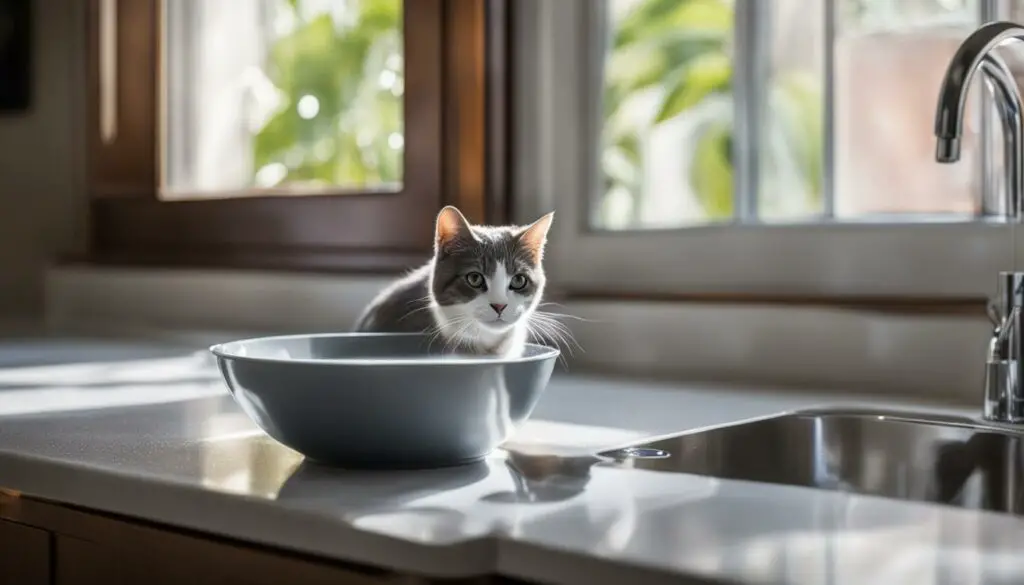
Transitioning from Free Feeding
Transitioning from free feeding to a structured feeding routine is a gradual process that requires patience and consistency. Here are some steps to help you make the transition successfully:
- Determine Calorie Consumption: Start by determining the amount of food your cat currently consumes in a 24-hour period. Measure the food left out before refilling and calculate the average daily consumption. This will give you a baseline to work with.
- Reduce Free Feeding: Gradually reduce the amount of food left out for free feeding. Begin by pulling the food at certain times, such as overnight or when you’re away. This will help your cat adjust to the idea of scheduled meals.
- Introduce Timed Meals: Start incorporating scheduled meal times into your cat’s routine. Feed meals at the same time every day, preferably in a designated area. Use a signal, such as a word or sound, to let your cat know it’s mealtime.
- Monitor Portion Control: Track your cat’s intake during meals to ensure they are receiving appropriate portions. Adjust the amount of food at each meal based on their calorie needs. Gradually increase or decrease the portion size as needed.
Remember, cats are creatures of habit, so consistency is key. It may take some time for your cat to adjust to the new feeding routine, but with patience and persistence, they will adapt to the structured schedule.
“Transitioning from free feeding to scheduled meals is beneficial for cats’ health and weight management.”
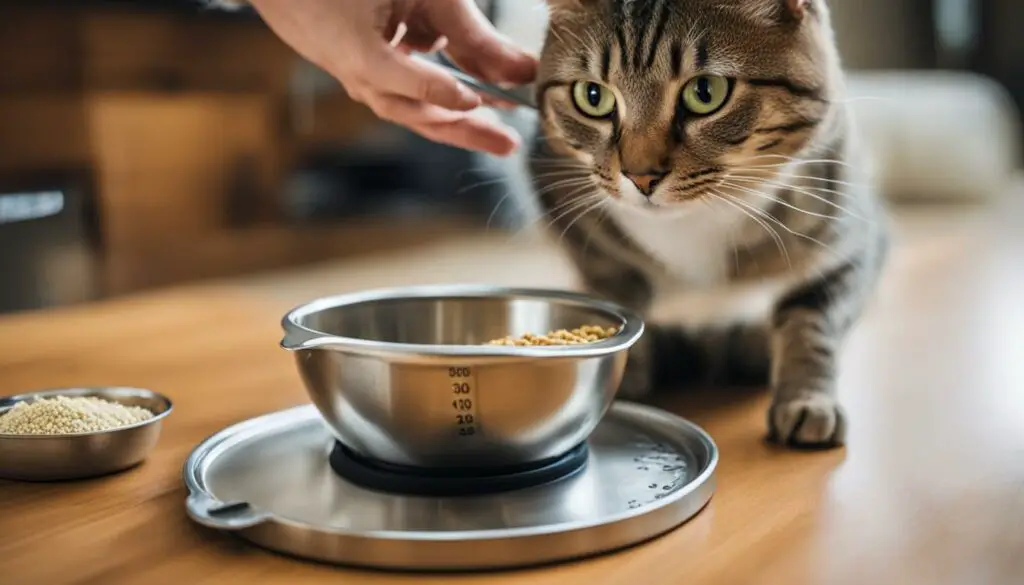
By transitioning from free feeding to a structured feeding routine, you can help prevent obesity and promote healthier eating habits for your cat. Providing them with appropriate portion sizes and scheduled meals ensures they receive the nutrients they need without the risk of overeating. Remember to consult with your veterinarian for guidance and support throughout the transition process.
| Benefits of Transitioning from Free Feeding |
|---|
| Prevents obesity |
| Promotes healthier eating habits |
| Ensures appropriate portion control |
| Supports weight management |
| Provides necessary nutrients |
Summary
Transitioning from free feeding to a structured feeding routine is a gradual process that requires careful planning and consistency. By determining your cat’s calorie consumption, reducing free feeding, introducing timed meals, and monitoring portion control, you can successfully transition your cat to a healthier feeding routine. Remember to be patient and consult with your veterinarian for guidance throughout the process.
The Benefits of Timed Meals
Transitioning from free feeding to a structured feeding routine is highly beneficial for cats in terms of controlled feeding and weight management. By implementing timed meals, pet owners can promote a healthy metabolism, prevent overeating, and ensure their cats receive the necessary nutrients for overall well-being.
According to experts, cats have a naturally high protein requirement, and timed meals allow for a balanced diet consisting of animal-based protein sources. This controlled feeding approach helps prevent excessive carbohydrate consumption and promotes optimal feline health.
Furthermore, timed meals make it easier to introduce new foods and monitor portion sizes. By measuring and providing precise amounts of food at designated meal times, pet owners can effectively manage their cats’ calorie intake, preventing obesity and associated health problems.
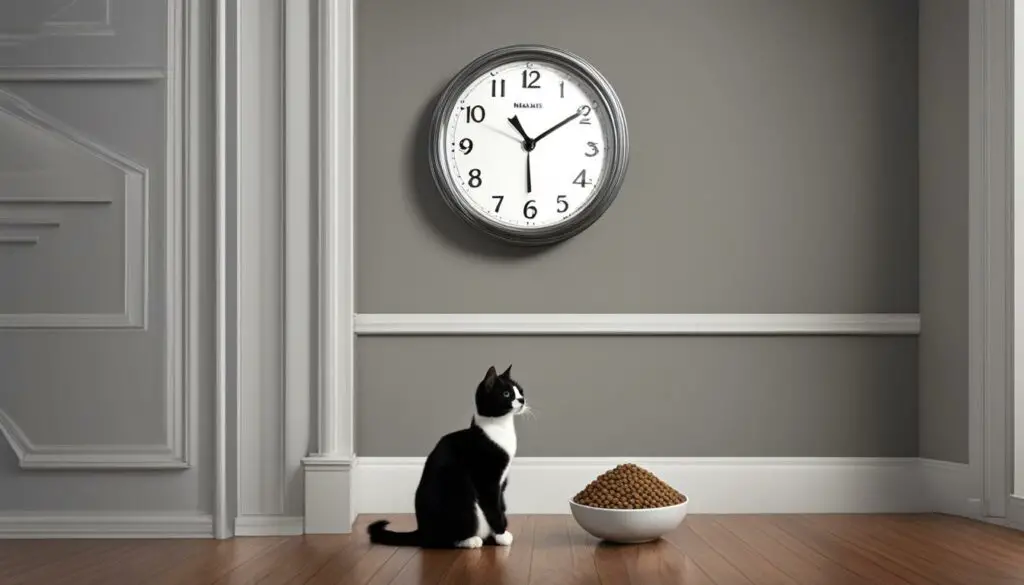
The Importance of Consistency and Consultation
Consistency is key when transitioning cats to timed meals. It is essential to establish a regular feeding routine, offering meals at the same time every day. This consistency helps cats adjust and understand their feeding schedule, eliminating any anxiety or confusion.
Additionally, consulting with a veterinarian during this transition is highly recommended. A veterinarian can provide personalized guidance based on the cat’s specific needs, including any health conditions or dietary restrictions. Regular check-ups allow for adjustments to the feeding plan, ensuring the cat’s nutritional requirements are met.
In conclusion, implementing timed meals for cats offers numerous benefits, including controlled feeding, weight management, and overall improved health. By following a structured feeding routine and seeking guidance from a veterinarian, pet owners can provide their cats with the best possible nutrition and support their long-term well-being.
Tailoring Feeding Strategies for Specific Health Issues
Cats with specific health issues require tailored feeding strategies to manage their conditions effectively. Consultation with a veterinarian is essential in creating a feeding plan that addresses their unique needs. By following a customized feeding routine, cat owners can promote weight management and support overall health.
For cats with hepatic lipidosis, a condition where excessive fat deposits accumulate in the liver, a high-quality, highly digestible diet is recommended. The feeding plan should focus on providing adequate nutrition while being gentle on the liver. It may involve smaller, more frequent meals to prevent the cat from becoming overweight or developing fatty liver disease.
Meanwhile, cats with feline hyperthyroidism, an overactive thyroid gland, may benefit from a diet that is low in iodine. This can be achieved by feeding commercial cat foods specifically formulated for hyperthyroidism. These diets help control the condition by reducing the production of thyroid hormones and managing weight.
Other health conditions, such as diabetes or kidney disease, may require additional dietary adjustments. Cats with diabetes may benefit from a low-carbohydrate, high-protein diet to regulate blood sugar levels. For cats with kidney disease, a diet that is low in phosphorus and high in quality protein can help manage the condition and slow its progression.
| Health Condition | Recommended Feeding Strategy |
|---|---|
| Hepatic Lipidosis | High-quality, highly digestible diet; smaller, more frequent meals |
| Feline Hyperthyroidism | Low-iodine diet; commercial cat foods for hyperthyroidism |
| Diabetes | Low-carbohydrate, high-protein diet |
| Kidney Disease | Low-phosphorus, high-quality protein diet |
Working closely with a veterinarian is crucial in managing these health conditions and ensuring that the feeding plan is tailored to the cat’s individual needs. Regular check-ups and monitoring can help make necessary adjustments to the diet as the cat’s condition progresses or changes over time.
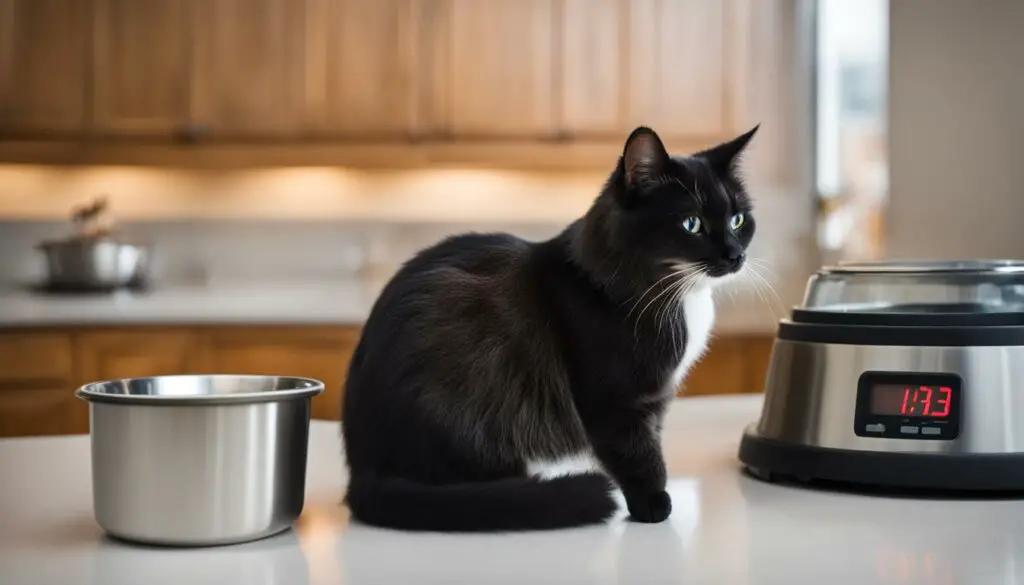
Conclusion
Tailoring feeding strategies for cats with specific health issues is essential to their overall well-being. By working closely with a veterinarian and following a customized feeding plan, cat owners can support weight management, control diseases, and ensure the best possible quality of life for their feline companions.
Conclusion
In conclusion, transitioning cats from free feeding to timed meals is a crucial step in promoting their health and overall well-being. By implementing a structured feeding routine, pet owners can effectively prevent obesity, manage weight, and provide cats with the appropriate nutrients they need.
Consistency and patience are key during this transition. It is important to consult with a veterinarian to assess the cat’s current health, obtain guidance on dietary modifications, and monitor their progress. Regular check-ups allow for adjustments to the feeding plan based on the cat’s specific needs, including any health issues or disease management.
Controlled feeding for cats offers numerous benefits, such as promoting a healthy metabolism, preventing overeating, and aiding in weight management. It also makes it easier to introduce new foods and ensure that cats receive the necessary nutrients for their overall well-being.
By following a balanced feeding schedule tailored to their individual needs, pet owners can support their cat’s energy requirements and prevent health problems associated with excessive carbohydrate consumption. Transitioning from free feeding to a structured feeding routine may require time and patience, but the long-term benefits are well worth the effort.
FAQ
How do I transition my cat from free feeding to a scheduled feeding routine?
Start by pulling the free-feeding kibble at certain times, such as overnight or when you’re away. Feed only timed meals during the day and gradually increase the amount of food at each meal to meet their daily caloric needs.
How many meals a day should I feed my cat?
Aim for at least three meals a day, adjusting the number of meals based on your cat’s age, health, and activity level.
Can I use treats to alleviate stomach acid buildup during the transition?
Yes, offering small treats between meals can help absorb stomach acid and relieve vomiting.
How do I manage feeding multiple cats with different dietary needs?
Tailor meal plans based on each cat’s age, energy level, and health conditions. Use automatic feeders to ensure each cat receives the appropriate portion and timing of meals.
When should I consult with a veterinarian about my cat’s feeding schedule?
It is recommended to consult with a veterinarian to assess your cat’s current health, receive guidance on dietary modifications, and monitor their progress. Regular check-ups allow for adjustments to the feeding plan based on the cat’s specific needs.
How can I incorporate hunting activities into my cat’s feeding routine?
Use puzzle feeders or hide small amounts of food around your home to stimulate your cat’s brain and encourage physical activity.
How can I ensure my cat stays hydrated?
Provide fresh water in a clean dish separate from their food plate. Some cats prefer running water, so consider investing in a water fountain.
Is transitioning to a timed feeding routine a gradual process?
Yes, start by gradually reducing the amount of food left out for free feeding and introduce scheduled meal times. Consistency and patience are key during this transition.
What are the benefits of timed meals for cats?
Timed meals promote a healthy metabolism, prevent overeating, aid in weight management, and provide the necessary nutrients for a cat’s overall well-being.
How should I adjust feeding strategies for cats with specific health issues?
Work closely with a veterinarian to create a tailored feeding plan that addresses their health concerns. Regular check-ups and ongoing support can help manage weight, control diseases, and ensure the cat’s overall health.

